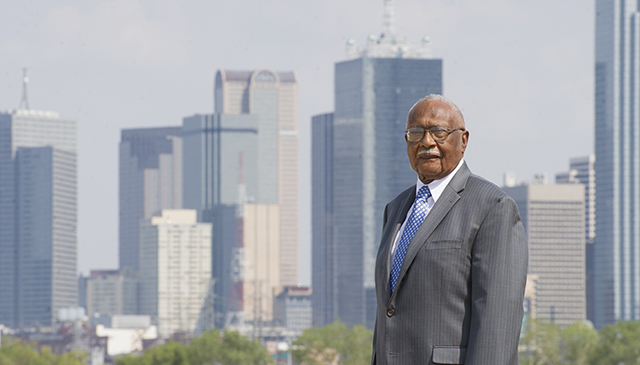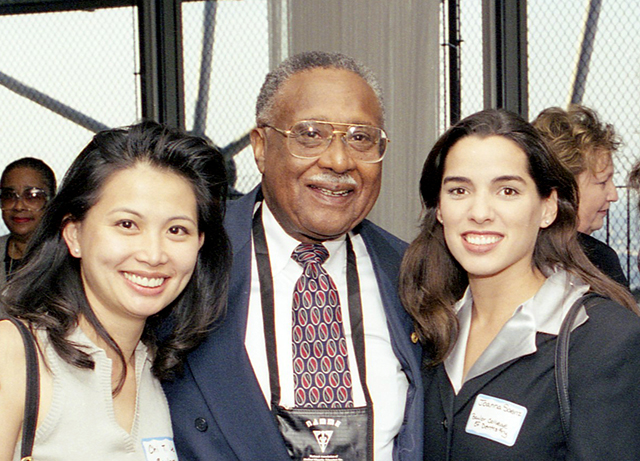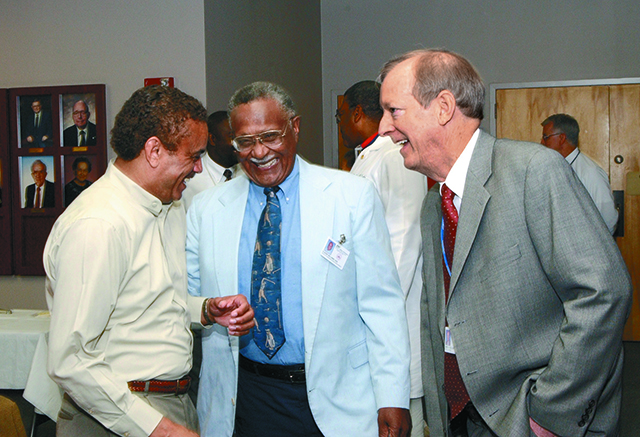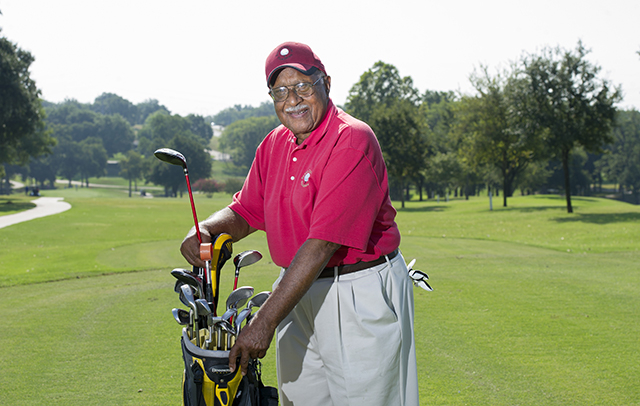City of dreams

The prospect of change lured Dr. Claude Williams to Dallas. After 44 years, his quest to foster inclusion still spurs opportunity.
This article originally appeared in the Spring 2014 Baylor Dental Journal.
We crowd into the elevator, and the questions start. Dr. Claude Williams knows this process well. We’re giving a campus tour to dental assisting students from Kaplan College. One young man recognizes Williams, asks him about his service in the Navy. There are more questions from others who want to know about this pioneer: the first African-American orthodontist in the Southwest and the first African-American faculty member at Texas A&M University Baylor College of Dentistry. Williams answers as many students as he can, but time during the campus visit is limited.
Later in July, we meet several times for his retirement profile story. Williams reclines in his office chair as he talks, but when he leans forward, furrows his brow and widens his eyes, I know to listen closely. His words bring his struggles and aspirations to life.
In 1970, AS WILLIAMS WAS preparing to finish his orthodontic residency at Howard University in Washington D.C., he got a call from two good friends: Dallas physicians Drs. Emmett Conrad and Robert Prince.
In those fragile years in Dallas following the Civil Rights movement, the city along the Trinity was on the verge of integration and growing like crazy. And even though the Kennedy assassination was almost a decade in Dallas’ past, the city desperately needed to recreate its identity and shake its smeared reputation as a “city of hate.”
The African-American community was trying to build a middle class of blacks in Dallas, Conrad and Prince told Williams. And they had an important question for him. Would he come back to be a part of it?
Dallas wasn’t on Williams’ short list. The very reason the former Marshall, Texas, dentist closed his practice, abandoned his home and left for D.C. to pursue an orthodontic education was because, two years earlier, every orthodontist he consulted in the state of Texas refused to provide care for one of his 11-year-old twin daughters because of the color of her skin.
“Could you imagine having a daughter who needed orthodontic care and no one would treat her?” says Williams. “I had to re-evaluate a lot of things in my life. How do you respond to the rejection?”
But Williams couldn’t deny the opportunity to be a part of lasting change.
So he went right into the thick of things.
The decision to accept Conrad and Prince’s invitation was a good call. By 1973, business at Williams’ South Dallas orthodontic practice was bursting at the seams.
“Naturally I had a built-in population group because white orthodontists wouldn’t treat black people,” Williams recalls.
He took his first patient before even moving back to Dallas. Conrad’s daughter, Cecilia Conrad – now vice president of the MacArthur Fellows Program based in Chicago – was in junior high at the time.
“I was the first kid in my school and the first kid I encountered in South Dallas who had braces,” she says. “I was a walking community educator and advertisement.”
Williams’ spare hours were spent volunteering at the Children’s Medical Center of Dallas dental clinic. It wasn’t long before word spread.
Two enterprising faculty members – Drs. Robert Gaylord and Tom Matthews – had created A&M Baylor College of Dentistry’s graduate orthodontic program a decade before. It was growing, and Gaylord and Matthews knew just whom they wanted to add to their team. Williams said yes to his professional suitors and began teaching orthodontics a half day each week. He would go on to stay at the dental school for four decades.

GROWING UP IN MARSHALL, home for Williams was a four-bedroom house surrounded by peach and pecan trees. There was a swing on the L-shaped front porch where he liked to sit. Just two blocks away was Wiley College, a historically black school, still segregated at the time. He’d zip over on his bike after school because it was the only place in town with paved roads in the black community.
Dr. Kelso Morris, the chemistry professor, was his idol.
“I admired him, number one, because of his academics, but also because he was recognized as a community leader,” says Williams. “You would hear people talk about how they admired him. That’s what I wanted to be. In the background that was just my goal in life.”
ROLE MODELS were never far away in Marshall. Williams saw Morris, along with his own schoolteachers, everywhere around town – at Moon’s Grocery Store, during movie nights at the college and at Sunday service at Ebenezer United Methodist Church, where they would sit on neighboring pews.
Expectations were high.
“We always got used books from white high schools, but we had outstanding teachers in the basic philosophy of education,” says Williams. “They instilled in us commitment to learning and living. So they had constant influence at school and in the community.”
Then there was the fraternity.
Members of Alpha Phi Alpha, a traditionally African- American organization, were known for their scholastic achievements. Williams liked that. He’d see them often, whether he was on campus riding after school or helpingdirect traffic for football games with fellow Boy Scouts. They were just part of the fabric.
“They would wear different attire every day of rush,” he recalls. “The last day of the initiation process they wore white suits. Their lives seemed to be in order.”
Grade school led to high school, and with graduation, opportunity. Williams attended Wiley College on a $50 scholarship. He arrived early and picked a spot in the front row the first day of class. Getting around campus was tough, since he’d undergone an appendectomy just two weeks before – an operation for which his parents had saved for an entire year just to be able to pay.
“During that time, in the ‘old days,’ you’d take a month off after surgery,” says Williams. “I didn’t want to wait a month; I wanted to go to college.”
He learned chemistry from his idol and donned the crisp white suit of his Alpha Phi Alpha fraternity brothers, even became the chapter president. By 1948, after two good years at Wiley, student unrest had Williams looking east to Howard University. By 1954, he had earned his bachelor’s and dental degrees at that institution, and 16 years later, it’s where he earned his certificate in orthodontics.
WILLIAMS’ MOTHER, like his aunts, was a teacher. His father built railroads during the Great Depression. But that work was not to last. When his dad took a job for $2.50 a day as a janitor at Southern Methodist University, Williams – an only child – split summer vacations between long days on his grandmother’s farm in Jefferson, Texas, and visits to his dad’s garage apartment on Stratford Avenue in Highland Park.
As early as age 5, Williams would walk to campus with his dad. He soon found himself under the watchful eye of a female faculty member from the chemistry department. While his dad mopped and cleaned, Williams learned. The kind woman never missed an opportunity to teach.
“She kept a lot of chemicals on the desk,” says Williams. “I would ask her, ‘How would you know what things to mix first?’ She said, ‘There is an order in science that you need to have and an order in your life that you need to have.’ She said, ‘You’re black, so you’re going to need to be twice as good.”
THE FARM IN JEFFERSON offered learning experiences, too. It was there Williams’ grandmother taught him to draw water from the well. There was no plumbing at that old farmhouse, so he would pour his bath water into a metal tin tub early in the morning, warming it in the Texas sun until nightfall. The time in between was spent working the fields and learning how to catch and harness the mule, Tib. Once the day grew too hot, he’d escape to the lake to fish.
If Williams wasn’t with his grandmother, chances were he was alone, since none of his cousins opted to go to the farm.
Nights were spent reading the Bible by the fireplace. His grandmother loved to sing hymns, and sometimes Williams would join in. He sings in the church choir to this day.
IN THE EARLY ’70s the Tweed method, a process for diagnosing and treating malocclusion, was king. There was just one problem: “The total concept of the Tweed treatment was not flexible for people of other races,” Williams says.
His education at Howard included a diverse group of patients, which allowed him to learn several treatment modalities. Two of them – the twin wire mechanism and several edgewise treatment techniques – allowed the basic concepts of the Tweed method to be expanded. Williams implemented these at TAMBCD, and the timing was good, as the college’s patient pool was steadily diversifying.
Soon enough, the same was true for dental students. TAMBCD integrated in 1974. In 1978 his son, Claude Jr., enrolled. It was a source of immense pride and strain for Williams. Even though segregation was a thing of the past, the mindset behind it was at times very much alive. Watching his son struggle was hard.
But Williams remained loyal to the college.
“They brought black dental students in, but they had not prepared the faculty, staff or students,” says Williams. “They would bring them in with no support there. They had a very difficult time.”
It didn’t take long before minority students started showing up at the clinic and even Williams’ practice. “I’m having problems; can you help me?” they would ask.
So Williams invited students – his son among them – to his practice so they could observe his style of practice management and, under the careful supervision of African-American lab technicians, learn to carve wax patterns.
“I was determined then that I would work within the system of the school so that no other child would have to go through what my child went through,” Williams says.
It was not the first time Williams had to step back to re-evaluate his place in life. He found it natural to apply that same lens to the dental school environment.
BY EARLY 1983, Dallas’ population had grown to more than 900,000. Opportunity was ripe to develop what remained of the city’s open spaces, and business boomed.
What was curious wasn’t so much about what had happened as opposed to what hadn’t. At the time nearly one-third of Dallas’ population was African-American, yet the city had been largely untainted by urban riots, deep ghettos and high unemployment.
Like many cities in the South, Dallas was known for its prejudices. But the sentiment among the city’s growing middle class of African-Americans was that it wasn’t enough to deter them from a rewarding career, according to an article in the January 1983 Ebony magazine.
It was in these environs that Williams laid the foundation for the college’s outreach and pipeline programs. In the early 1990s, with support from the administration and then-dean Dr. Dominick DePaola, Williams formed the Office of Minority Affairs. The role took Williams out of the orthodontic department but allowed him to shape the early direction of what is now known as the Summer Predental Enrichment Program.
In the years since, the program has evolved under the careful guidance of the Office of Student Development and Multicultural Affairs, helping to make the dental school one of the most diverse in the country.
All of Williams’ efforts zeroed in on one goal: increasing access to care for those in underserved areas.
“Everything I have done since the beginning has been toward that cause,” Williams says.
Williams used his local, state and national connections to forge long-lasting partnerships for the college. Such has been the case with the school’s longtime role in the Emmett J. Conrad Leadership Program. Summer educational outreach involved the help of Dr. Tom Diekwisch, former assistant professor in biomedical sciences and creator of the Habitat for Science program, which provided hands-on lab activities and discussions for high school seniors from inner-city neighborhoods.
“I think Claude is quite different from many people today,” says Diekwisch. “You could see how hard he had to work for what he had accomplished and how he had to fight, and how he made a difference in where he was.”

For years during Black History Month, Williams saw to it that students, faculty and staff had the opportunity to hear notable African-American speakers.
He also brought TAMBCD into the community.
DR. JAMES COLE, dean emeritus, went with Williams on several visits to Dallas movers and shakers, including elected officials’ local offices.
“If there was something that we needed to resolve at the state level, Claude could really help in that way,” says Cole. “Whether they were state representatives or senators, it was obvious he had known those individuals and their staffs for years.”
The car rides provided ample time for Williams to share his stories from decades past. He’d tell Cole about what it was like trying to get into Dallas country clubs or the trials of shopping for a car.
“Before then I’m just not sure that I appreciated the depth of segregation and what it was like for Claude and others,” says Cole. “It was an education for me, because of his experiences.”
Along the way, Williams mentored and counseled minority students as they navigated the mires of dental school. “I don’t think I would have made it through dental school without him,” says Dr. Angela Jones ’01, who maintains a private dental practice in Dallas’ Oak Cliff, not too far from where Williams ran his practice until retiring in 2000.
“He was the most helpful person at Baylor for me,” she says. “He always listened; the door was always open. Whatever I needed he was there. Dr. Williams went to bat for us.”
His influence went beyond the college – to the farthest reaches of the globe even – like in 1995, when Williams traveled to the Third African-African-American Summit in Dakar, Senegal, located on Africa’s western tip. He was one of just six U.S. dentists invited.
More recently, in a conference room at the American Dental Association headquarters in Chicago, Williams recounted his professional journey to more than 75 dental association presidents, past presidents and student leaders from across the country.
By the time he was done, the audience had dissolved into tears.
“There wasn’t a dry eye in the house, to convey the kind of story that he did,” says Dr. Nathan Fletcher, a National Dental Association past president, who asked Williams to speak at the ADA-sponsored 2010 diversity summit.
“Some found it incredulous. Some probably were in disbelief,” says Fletcher. “But when you have a man standing at the podium telling his life story you really can’t deny the fact and verification of it.
“That story is kind of the epitome of who he is. He saw the bigger picture and generated legacies for other people, primarily African-American, to get into the profession and be successful. That’s not a story that a lot of people know.”
Top of his game

Throughout all of the interviews for this article, a theme came to light: Every single person mentioned Dr. Claude Williams’ love of golf – a sport he picked up as a young Naval officer in Maryland. Dr. Tim Meyers of Atlanta graduated from Howard’s orthodontic program in 1970, and they, along with two other classmates, get together several times a year to play, flying in to golfing destinations from their respective homes in Dallas, Atlanta, Virginia and North Carolina; although you’re just as likely to see Williams teeing off close to home at Cedar Crest or Stevens Park in Dallas.
“It’s hard to say who is the better player,” says Meyers. “The old man holds his own most of the time from what I hear. I’ve lost money from betting against him – several times.”
—Jenny FuentesThis article originally appeared in the Spring 2014 Baylor Dental Journal.